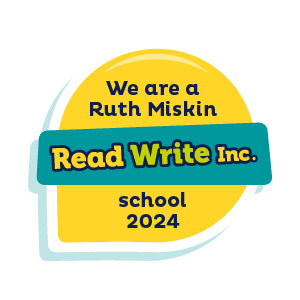Read Write Inc Phonics Scheme
Read Write Inc Phonics Scheme 
Read, Write, Inc is the phonics scheme we use to teach reading and spelling in Early Years and Key Stage One. We have chosen Read, Write, Inc because we want our children to flourish in their reading. The scheme takes onboard and values each child’s ability level giving them targeted support in order to get them reading as quickly as possible. We use the knowledge of their phonic skills to encourage all children to read widely and become lifelong readers.
Teaching Phonics at Ropsley
We start teaching the programme in your child’s Reception year and then continue until they have worked their way through the whole reading scheme, usually this is during Year One or Two. We assess all children on the scheme every 6-8 weeks, to ensure that they are placed in the perfect group for their reading ability. This also allows us to quickly identify any children who need some support to access the learning at the level of the group. If this arises, we provide one-to-one tutoring for the child in accordance with the Read, Write, Inc scheme, to help them make rapid progress and once again be at the level of their group. Groups are taught by either teachers or LSAs who have had Read, Write, Inc phonics training; in utilising so many staff, we can ensure that groups are kept as small as possible and that the teaching the children receive is tailored to their needs. Sessions in Reception are 20-30 minutes long and then 45 minutes long in Key Stage One.
Children begin by learning the Set 1 sounds in a specific order. They also begin learning to blend sounds together to make words after learning the first 5 sounds, firstly through practising oral blending. Then, when they can blend independently, they progress on to reading green words.
As soon as children can read green words, they begin to read stories in their Read, Write, Inc sessions. Each storybook is matched to the sounds they can already read, which sets them up for success and helps to build their confidence with reading. It is through these storybooks that we teach children red words, which are irregular words that are not phonetically plausible and cannot be sounded out (fred talked). Each storybook is taught in the same way, with children practising reading the green words in the story and also the red words, before they begin to read the book. Children will then read the book several times to help build their fluency and comprehension skills.
How to help at home
Read to your child
Even if your child is not yet reading words, it is so important to read stories to them. The film below explains the benefits of reading to your child:
There are also some things to think about when reading to your child:
Fred Talk
To expose your child to the idea of blending sounds together to make words, break down the words of the simple vocabulary you often use at home. For example, “please pass me that c - u - p”, “let’s sit on the r - u - g”. This will help your child to practise their oral blending as they can repeat the sounds back to you and then say the word.
Building vocabulary
Children need a rich vocabulary in order to develop high levels of comprehension. The more words your child has in their vocabulary, the more they will understand when they read. You could try using alternative words for things at home, rather than saying you are pleased that they have tidied their toys, you could say that you are delighted, ecstatic, overjoyed.
Reading with your child
Your child will bring home reading books to share with you:
-
a Book Bag Book which corresponds to the colour band they are on in Read, Write, Inc sessions
-
an Oxford Reading Tree book which the children choose themselves from a specific band
-
a version of the book they are reading in their Read, Write, Inc session.
When helping your child to decode words at home, it’s really important to pronounce the sounds correctly. Here is a helpful guide to show you how we are teaching your child to pronounce the sounds:
Practising the sounds
If your child is struggling with learning to blend, there is a useful video on the Ruth Miskin Youtube channel called ‘Parent video: sound blending’, which demonstrates an activity you could do to support your child. This activity is very similar to the type of one-to-one support we would give your child at school if they need it.
The website below has been created by Read, Write Inc. to demonstrate the pronunciation of sounds.
https://www.oxfordowl.co.uk/for-home/reading-owl/find-a-book/read-write-inc-phonics--1/phonics-pure-sounds-video
RWI Glossary:
|
Term |
Definition |
|
Fred |
Fred is a frog puppet we use in sessions. He can only speak in sounds. |
|
Fred talk |
sounding out a word, saying each of the sounds before blending |
|
Fred fingers |
‘Pinching’ each sound from a word on your fingers to help spell a word |
|
Green words |
Decodable words |
|
Red words |
Irregular words that cannot be sounded out |
|
Story Green words |
decodable words that will be included in the storybook |
|
Speedy green words |
decodable words in the storybook that children should be able to read at speed rather than fred talking first. |
|
Fred in your Head |
still sounding out a word but doing so in your head rather than out loud, helps build fluency. |
|
Special friends |
Two or three letters working together to make one sound e.g. sh, ch, igh, air, a-e, i-e. |
Useful resources
-
Oxford Owl - https://home.oxfordowl.co.uk/reading/reading-schemes-oxford-levels/read-write-inc-phonics-guide/
-
Ruth Miskin facebook page- https://www.facebook.com/miskin.education
-
Ruth Miskin website, parents section- https://www.ruthmiskin.com/en/find-out-more/parents/
-
Phonics play - games for each ability
REMEMBER: Phonics is not the only way you become a good reader. Continue to read with your child each night and encourage them to:
Sound out, re-read to check it makes sense, and highlight those tricky 'red' words.
Ask questions about the book;
And most importantly ENJOY READING!
